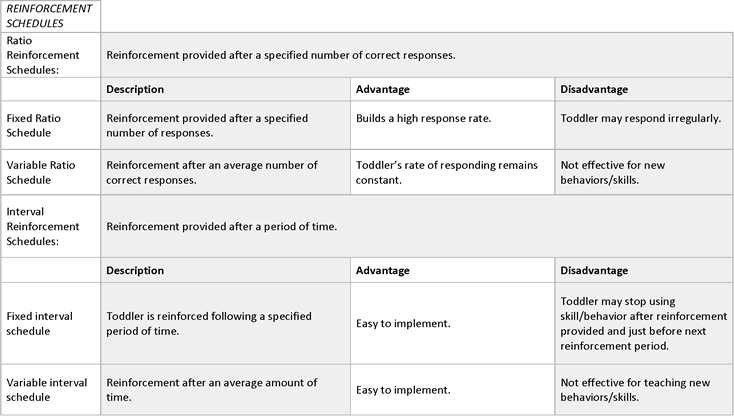Step 1.7 Select a schedule of reinforcement
The schedule for reinforcement refers to the timing and frequency of the delivery of reinforcement after the toddler performs the skill/behavior. Reinforcement is delivered either continuously or intermittently.
Generally, continuous reinforcement means the reinforcement is delivered each time the toddler uses the skill/behavior until the skill/behavior is learned. Continuous reinforcement helps the toddler learn new skills quickly, but can lead to satiation. Once the toddler learns the behavior, as evidenced by them meeting a pre-established criterion, the reinforcement may be delivered intermittently. Intermittent reinforcement helps to maintain the skill/behavior over time, and should be used after the toddler learns the new skill/behavior.
Moving from a continuous to an intermittent schedule of reinforcement is an example of reinforcement fading. Fading of reinforcement is an important step to helping the toddler learn to use the skill without the need of secondary reinforcers so that he or she can better generalize the target skill/behavior to other people, places, and activities. Intermittent reinforcement schedules can be either ratio or interval. Ratio schedules deliver reinforcement after the toddler does the skill/behavior. Interval schedule reinforcement is provided after a certain amount of time has passed.
Both ratio and interval schedules can be fixed or variable. Once the toddler learns the skill better, using these schedules ensures higher rate of success since the toddler isn’t aware of when reinforcement will be provided. Providers and families generally use a variable schedule as they provide reinforcement. At home, mom and dad have their attention pulled in various directions and will find it more challenging to provide reinforcement for every occurrence of the toddler’s skill/behavior. The following chart describes in more detail the differences between these reinforcement schedules.

The following video shows an example of fixed ratio reinforcement and variable ratio reinforcement.
 Video: Fixed and Variable Ratio Reinforcement
Video: Fixed and Variable Ratio Reinforcement
In determining the best schedule for providing reinforcement to the toddler remember the following:
- General continuous reinforcement is best as the toddler learns a new skill.
- Fixed schedules are more effective for shaping behavior.
- Variable schedules are useful for helping a toddler maintain a skill.
The following table summarizes the different reinforcement schedules:



